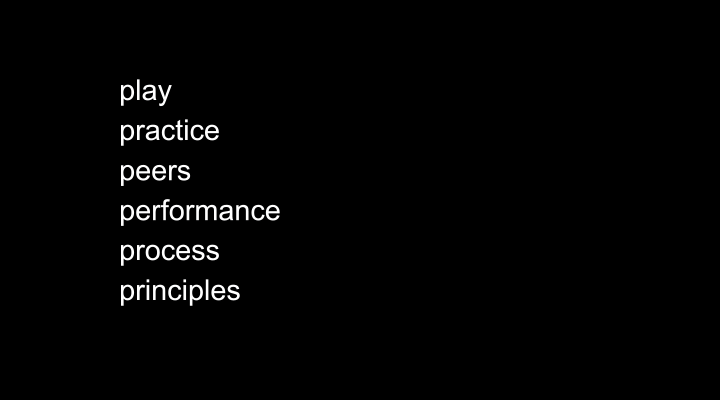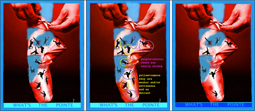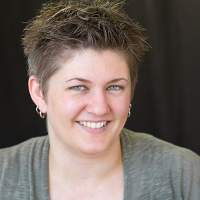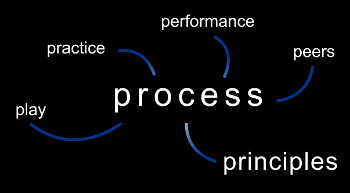Tisha Turk
Introduction
click here to download a transcript of this video
I want to talk about six key elements of technological professional development:

These six elements are interrelated in various ways: play and practice are both part of process, peers inform performance and vice versa, principles are generated by observations about the other elements, and so on.
In my experience, process and principles are especially important to technological professional development. But they are also the elements most likely to get lost when time is limited or to be subordinated to the understandable desire to learn something specific, concrete, and immediately usable. Who doesn’t want to learn about a specific piece of nifty software? But for those of us who want to keep developing, it’s especially important not to lose sight of process and principles: to reflect on what we’re doing, to extrapolate, to theorize.
Play
Playing means messing around, getting comfortable with tools (and ideas), getting a sense of how they work and what they can or can’t do. It’s open-ended learning-by-doing, learning through low-stakes failure: experimenting until something breaks. It’s an important part of learning to learn. It can be either solo or social, and the social version can be either playing-near or playing-with. It’s “I wonder whether I can…” and “What happens if I…?” and “How did you…?” At its best, it’s the early stages of hard fun.
Play takes time. As Ellen Seiter notes, “many digital skills” require “hours of trial-and-error” to acquire (36). Part of the point of play is that it’s ongoing, and the play changes as the player learns more and can conceptualize more complicated possibilities. Because most professional development sessions have only a limited amount of time for play, we may have to make our own time outside the time constraints of workshops—which can be challenging, given the other constraints on our time.
Play works best when it’s self-motivated and self-directed, or at least when external expectations match up pretty well with what the player wanted to do anyway. One of the advantages of a setting like DMAC is that participants are self-selecting: if we didn’t want to play around with the tools of multimodal composing, we probably wouldn’t be there. In a professional development (or teaching) situation in which participants are less self-selected or less enthusiastic, play becomes even more important but also potentially more difficult: people who just want to show up, learn something, and leave may resist the open-ended exploring that play requires.
Practice
If play is about discovery and experimentation, practice is about internalization and focused use. Play is how I figured out what I could do with text effects in Adobe AfterEffects; practice is how I learned the keyboard shortcuts for my favorite effects.“Interest” gets someone in the door but not out the door to any deep place unless it leads to lots and lots of practice and persistence past failure.
The movement between play and practice is, ideally, recursive: practice builds on play but also motivates further play; play helps learners figure out whether a particular tool makes sense for our interests and needs and thus helps us make informed choices about the narrower focus of practice.
– James Paul Gee
Instructional sessions and assignments tend to direct practice to specific areas; participant-chosen projects are an opportunity to self-direct by choosing what to practice or develop from earlier play. In professional development settings, both assigned and self-directed practice can be useful for us as teachers; they help us get a sense of how long a task might take and what kinds of pitfalls our students might encounter. They help us develop assignments that are reasonable in focus and scope; they give us a concrete sense of what is feasible.
However, assignments can homogenize the kinds of practice learners are expected to do, and they can move learners out of the play phase too quickly. Learners who are still acclimating to a tool may find structured practice baffling; learners already familiar with a tool may find practice pointless. In both cases, additional play can help: it offers learners a chance to get more comfortable with the technology, on the one hand, or, on the other hand, time to explore what else a tool can do and perhaps to set more complex goals.
Peers
Anybody who’s worked with a writing buddy, participated in a good writing workshop, or spent much time in a writing center knows how important peer interaction can be to the composing process. Especially for those of us who are the only digital humanities geeks on our campuses, it’s exciting and restorative just to have some extended time with other people who are kicking these ideas around: to share play,Find multiple posses.
to give and receive input on practice.
– Elizabeth Losh
Parallel play and shared practice—that is, working near rather than working with—can be especially valuable to technological learning as a counterbalance to both solitary effort and group work. Working-near enables both the giving and the receiving of peer help at point of need, what James Gee calls “on-demand and just-in-time” information (142)—and, for most of us, learning new technologies creates many points of need:
- I’m stuck.
- There’s got to be a menu option for this somewhere.
- I finished editing, but I don’t know what export settings to choose.
- I broke something in the CSS.
- Why is the layer gone?
Someone else messing around with the same tool or process probably knows or at least can help figure out the answer. It’s the same principle that makes wikis work: nobody has to know everything if everyone knows (and contributes) something. As in master classes and writing workshops, we learn not just from what we do but from what others do: we learn by example (including tutorials) and also by teaching.
Performance
Play and practice, which promote open-ended learning, must be balanced against performance, which applies or demonstrates what’s been learned. Performance directs practice and gives it a goal: the presentation or distribution of knowledge synthesized or created by the performer. Composition studies usually calls this outcome product; performance reminds us that it can’t be separated either from the performer or from the audience. Performance isn’t something personal or internal: it’s done for people.
Just as writing assignments don’t always have to be graded, technological professional development performances don’t have to be formal. However, they should require us to externalize what we’ve learned and to make that learning visible to others. In the context of an extended professional development opportunity like DMAC, performance can take the form of a final project. In half-day workshops, there’s seldom time to start, let alone finish and share, such a project, and so the responsibility for performing is likely to rest with the participants. Under such circumstances, post-workshop performance is extra work, but that extra work is valuable because it forces us to test our understanding of what we’ve learned and to move from tacit to explicit knowledge—an important shift if we want to teach others what we’ve learned.
What form a performance takes and whether we perform for students, colleagues, or administrators depends on what’s been learned and what our purposes were in learning it. Publicizing what we’ve learned can make us not just better teachers but better colleagues and better members of our profession: it allows us to educate people about what we do and facilitate much-needed departmental and institutional conversations about the scholarly and pedagogical value of technology.
Process
The importance of process is such a foundational concept of composition studies and contemporary college writing instruction that it may seem redundant to even mention it,I now build in revision practices, whether through requiring a rough cut and then a fine cut of remix videos, or by marking up image assignments like the one pictured below, which assumes a revision even if it’s not technically required.
but I think it is worth mentioning because—as our students so often remind us—it tends to go out the window when we’re pressed for time.
– Virginia Kuhn

Technological professional development can be quite tool-oriented—and with good reason: most of us start the process of exploring tech’s possibilities by playing with a particular tool. Paying attention to process reminds us to think about how the tools can or should affect our goals for and decisions about a composition, and in particular how those tools might fit into—or modify, or usefully complicate—our approaches to planning, drafting, and especially revising. One of the most important things we can do as writing teachers is to help our students understand what substantive revision looks like and how to do it; those things may be quite different in multimodal compositions than in alphabetic text compositions.
Ideally, then, technological professional development needs not only to encourage but also to model revision. What does it mean to reconceptualize the goals of a multimodal composition, to re-imagine the needs of the audience, to rethink the relationship between form and content, to let form change content? And what does it mean to revise accordingly? Our answers to these questions, whether thoughtful or unexamined, will inform both our own multimodal compositions and our choices about how to integrate technology into our classrooms. Those answers, as much as our experimentation with specific tools and technologies, are what we need to develop through play and practice and to test through performance.
Principles
Effective technological professional development aimed at long-term efficacy focuses less on mastering specific tools than on understanding and evaluating the affordances and limitations of those tools and developing the flexibility needed to handle inevitable changes in the technological environment. Or, to put it another way: at its best, technological professional development is more than smart people playing with shiny things. We should be building theory together. Theorizing—identifying underlying principles of multimodality—is more important than ever because the pace of technological change means that most tools are at perpetual risk of becoming obsolete or simply not getting updated. The speed of change may tempt us to try to keep up with the latest toys, but in fact it’s all the more reason to focus on principles. Platforms differ, software changes, authoring tools come and go; design principles—of visual rhetoric, of pedagogy, of code—are less subject to the whims of developers or the market.
If we know the principles, we can always figure out what tools we need, what questions to ask, what tutorials to look for. A tutorial explains how, but it doesn’t necessarily explain why. Principles help us think about the why. Principles allow us to hack the CSS of Tumblr, WordPress, or Weebly—or build our own in a text editor. Principles enable us to not just use a particular piece of software to manipulate video clips but understand the reasons to manipulate those clips in the first place. Principles help us decide how to organize a big project, how to make a video visually coherent, how long a clip should be, how to learn tricks from TV and the movies, how and when to use effects, how to use text effectively, and so on.
Learning to use specific tools and platforms—Scalar, Korsakow, Audacity, Gimp, GitHub, HTML5, Initializr, even WordPress or Google Drive—matters, of course. But part of that learning must include meta-cognition about how we learn to use technologies and how we evaluate composing modalities. What are the affordances and limitations of particular technologies? How can (and should) they be integrated into different kinds of classrooms? How do (and don’t) they work with different pedagogical goals? When we leave professional development sessions or workshops thinking deeply about these questions, even if we don’t yet have answers, we’re better equipped not just to use what we’ve learned but to go on learning.
Conclusions
For trainers and workshop leaders, the practical implications of this framework for thinking about professional development should be obvious: consider how best to make time for play, encourage practice and performance, facilitate peer interactions, call attention to process, and theorize principles within the constraints of technological professional development sessions. Given that there’s never enough time for everything, what’s the best use of that limited time? What choices might facilitate ongoing engagement and development after the session ends?
For participants, this taxonomy can help us think critically about our professional development experiences, including our needs in relation to the strengths and limitations of specific sessions or workshops. What opportunities can we create for ourselves? If a workshop emphasizes practice, we may need to make time for open-ended playing on the one hand or theorizing on the other. If it emphasizes play, we may need to push forward into practice, performance, and the revision parts of process. For those of us who must explore and develop largely on our own, we may need to find or create a mutually supportive community of peers—perhaps at DMAC—with whom to go on developing and extending our technological and pedagogical expertise.
Works Cited
Gee, James Paul. “How Learners Can Be On Top of Their Game: An Interview with James Paul Gee.” Interview by Henry Jenkins. Confessions of an Aca-Fan. 23 March 2011. Web.
—. What Video Games Have to Teach Us About Learning and Literacy. Rev. and updated ed. New York: Palgrave Macmillan, 2007. Print.
Ito, Mizuko, et al. Hanging out, Messing around, Geeking Out: Living and Learning with New Media. Cambridge: MIT Press, 2009. Print.
Kuhn, Virginia. “Hacking My Head.” In “Hacking the Classroom: Eight Perspectives.” Computers and Composition Online. Spring 2014. Web.
Losh, Elizabeth. “Ten Principles for a Hacktivist Pedagogy.” In “Hacking the Classroom: Eight Perspectives.” Computers and Composition Online. Spring 2014. Web.
Seiter, Ellen. “Practicing at Home: Computers, Pianos, and Cultural Capital.” Digital Youth, Innovation, and the Unexpected (2008): 27-52. Print.
Video Credits
Music
American Football, “Five Silent Miles”
Peter Mulvey & David Goodrich, “Drumlin Trail”
The Connells, “Pedro Says”
Photos on Flickr
Mark Brannan, “Learn”
torbakhopper, “under my umbrella”
droetker0912, “Piece of a jigsaw”
Erich Stüssi, “writing”
Anne Davis 773, “learning”
Giulia Forsythe, “Learn Unlearn Relearn”
Fanworks on Tumblr
s4karuna, “Justice league Fancast”
onegirlinalltheworld, “core scoobies, seasons 1-7”
vespermartini (mix) & calikalie (art), “something good can work”
221BeeMine, “Lighting Mary”
pruehalliwell (gifset) & veronicaecholls (tags), “vmars: 1×01”
itsfuuh, “How to make a gif on Photoshop”
nonasuch, zine covers
consulting-doctor-in-camelot, “We are all stories in the end”
Fanworks on Dreamwidth & LiveJournal
Tisha Turk, “Vids and Composing Processes”
bironic, “Starships”
anoel, “Made for This”
astolat, “An Archive Of One’s Own”
paraka, “Podfic 101 Tutorial”
Fanworks elsewhere
Clémentine, “Avengers” (blule.fr)
Penwiper, Dalek knitting pattern (entropyhouse.com)
Fan Studies
Francesca Coppa, “Women, Star Trek, and the early development of fannish vidding,” Transformative Works and Cultures vol. 1.
Sites
DMAC
Computers & Writing Conference 2014
The Middle-Earth DEM Project
FanFiction.net
The Archive of Our Own
AnimeMusicVideos.org
Half a Moon
DOINK! Final Fantasy Exchange
Supernatural Wiki
TVTropes.org
TheForce.net
Author

Tisha Turk is an Associate Professor of English at the University of Minnesota at Morris, where she teaches courses on writing, fandom, composition studies, and narrative theory. She is working on a book about vidding and vidwatching.
